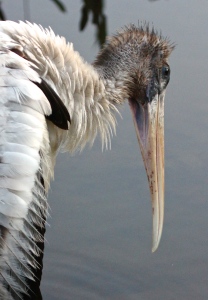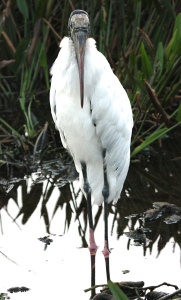When I first started noticing wading wetland birds on my trips to Florida about a decade ago, one particularly large, somewhat awkward-looking bird really caught my eye – the wonderful, one-of-a-kind Wood Stork! Wood Storks are the only stork native to North America, and they are found in the marshes, lakes, swamps and other wetlands of Florida.
 One often hears descriptions such as ‘A face only a mother could love’ when people refer to Wood Storks. But personally, I think these lovely creatures are just spectacular! They are uniquely beautiful with their bald heads and extra-long, thick bills, specially designed for capturing small fish and crustaceans in shallow water.
One often hears descriptions such as ‘A face only a mother could love’ when people refer to Wood Storks. But personally, I think these lovely creatures are just spectacular! They are uniquely beautiful with their bald heads and extra-long, thick bills, specially designed for capturing small fish and crustaceans in shallow water.  We are fortunate to have many breeding Wood Storks in our local wetland preserves. In fact, they are just coming back in greater numbers now, and will soon choose the best nesting spots for the season.
We are fortunate to have many breeding Wood Storks in our local wetland preserves. In fact, they are just coming back in greater numbers now, and will soon choose the best nesting spots for the season. However, these extraordinary birds are not doing well in most areas of Florida. “Like many Florida birds associated with wetlands, the Wood Stork has suffered from the destruction and degradation of our state’s wetlands. Today, the Wood Stork is classed “Endangered” by the State of Florida and the federal government.” (Source: http://fl.audubon.org/wood-stork)
However, these extraordinary birds are not doing well in most areas of Florida. “Like many Florida birds associated with wetlands, the Wood Stork has suffered from the destruction and degradation of our state’s wetlands. Today, the Wood Stork is classed “Endangered” by the State of Florida and the federal government.” (Source: http://fl.audubon.org/wood-stork)
Click on this link: “Endangered” to hear a program on NPR about a year ago on the current status of the Wood Stork. And, for even more intriguing information about these special creatures, listen to this: Wood Storks and Climate Change, a 2-minute audio piece posted on Bird Note not long ago.



We need to learn to share our world with wildlife!
LikeLiked by 1 person
Agreed, Sonja…They share it so graciously with us every day~!
LikeLike
Thanks for sharing this fascinating bird, it is sad to see so many endangered species due to climate change but more so man making changes for his own developments. The wetland and shore bird habitats throughout the world are diminishing due to development more than drought, in Australia we are loosing thousands of migratory shorebirds each year because of what is happening in the Asian countries with them filling in their wetlands and building on their coastlines. I am amazed at how many critically endangered species there are in our country alone. I was also surprised when looking through a book given me as a gift on parrots, to see how many extinct birds there are, which we will never ever see.
LikeLiked by 1 person
Yes. The more I read and learn about the impact of human development on birds’ (and other creatures’) very survival, the more committed I am to conservation organizations and efforts.
LikeLike
I keep meaning to say… I’m very impressed by the quality of your photographs. Thanks for moving to Florida. 😉
LikeLiked by 1 person
Thanks very much, Mike! You must come visit one day ☀️
LikeLike
Wonderful photos, my friend, and informative post. Many thanks for heightening our awareness. 🙂
LikeLiked by 1 person
We’re so lucky to have many sources of information available at our fingertips – thanks, Jet!
LikeLike
I agree! I love the bill. And it’s spiky little head and strong body!
LikeLiked by 1 person
The juvenile Wood Stork in several of these pictures was so close to the boardwalk that I was able to get a really CLOSE-UP view of the underside of his bill for the first time. Glad you like him, too, Yaffa – such an amazing creature~!
LikeLike
Very cool birds.
LikeLiked by 1 person
Thanks for your visit, Pat!
LikeLike
Tremendous shots of one of my favorite birds!
Did you know that wood storks have a sort of relationship with alligators? They will often nest above where alligators live because the gators will take care of predators such as raccoons and snakes that would take wood stork eggs or babies. But it’s not good if a stork baby falls out of it’s nest. Yikes!
LikeLiked by 1 person
Amazing!! ~thanks for sharing this interesting info, Phil, and thanks for visiting 😉
LikeLike
Reblogged this on Wolf's Birding and Bonsai Blog.
LikeLiked by 1 person